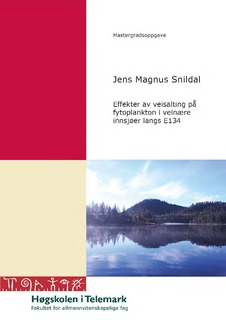| dc.contributor.author | Snildal, Jens Magnus | |
| dc.coverage.spatial | Telemark | |
| dc.coverage.spatial | Buskerud | |
| dc.date.accessioned | 2014-09-08T07:50:25Z | |
| dc.date.accessioned | 2017-04-19T13:13:56Z | |
| dc.date.available | 2014-09-08T07:50:25Z | |
| dc.date.available | 2017-04-19T13:13:56Z | |
| dc.date.issued | 2014 | |
| dc.identifier.citation | Snildal, J. M. Effekter av veisalting på fytoplankton i veinære innsjøer langs E134. Master thesis, Telemark University College, 2014 | |
| dc.identifier.uri | http://hdl.handle.net/11250/2438941 | |
| dc.description.abstract | Mange norske innsjøer opplever en økning i kloridkonsentrasjoner som følge av veisalting. Denne tilførselen kan påvirke ferskvannsorganismene direkte og indirekte, f.eks. gjennom endringer i sirkulasjonsmønster i innsjøene. Målet med denne oppgaven var å undersøke om veinære innsjøer langs E134 har forhøyede kloridkonsentrasjoner og om dette i så fall påvirker fytoplanktonbiomasse og samfunnsstruktur. Siden fytoplankton er plassert nederst i næringskjeden i det akvatiske økosystem, kan endringer i fytoplanktonsamfunnet ha stor betydning for høyere trofiske nivåer. Vannkjemiske og biologiske undersøkelser ble utført over tre prøverunder i juni, august og september 2013 i 17 veinære innsjøer og 3 referanseinnsjøer i Telemark og Buskerud. Fytoplanktonsamfunnet i innsjøene ble undersøkt både kvantitativt og kvalitativt. De fleste av prøvelokalitetene betegnes som mesotrofe med høyt humusinnhold (fargetall > 20 mg Pt/L, TOC > 5 mg/L). I 14 av lokalitetene ble det funnet tydelige oksygengradienter med lavere oksygenkonsentrasjoner i bunnvannet. I omkring halvparten av lokalitetene ble det også funnet en tydelig sjiktning i ledningsevne. 7 av de undersøkte innsjøene hadde kloridkonsentrasjoner > 2,1 mg/L i overflatevannet. 2 av disse innsjøene skilte seg ut med en tydelig kloridgradient (forskjell i kloridkonsentrasjon mellom bunn – topp > 10 mg/L). De statistiske analysene viste at forskjeller i kloridkonsentrasjon ikke har noen signifikant påvirkning på hverken fytoplanktonbiomasse eller artssammensetning i innsjøene. Det ble likevel funnet noe høyere fytoplanktonbiomasse i innsjøene med klorid > 2,1 mg/L. Dette tyder på at en moderat økning av ioner i lokalitetene gjør at fytoplanktonartene kan bruke mer energi på primærproduksjon i stedet for osmotisk regulering. Analysene viste også at fytoplanktonsamfunnene i hovedsak styres av andre fysiske/kjemiske/biologiske variabler enn klorid. pH og kalsium hadde stor forklaringsverdi, men i tillegg var det en del av miljøvariasjonen i ordinasjonsanalysen som ikke ble fanget opp av de målte parametrene. Viktige næringsstoff for fytoplankton som fosfor og silisium kan tenkes å fange opp noe av denne variasjonen. I tillegg kan det tenkes at inkludering av dyreplanktonsamfunn i analysen også vil kunne fange opp noe av miljøvariasjonen. | |
| dc.description.abstract | A lot of Norwegian lakes experience an increase in chloride concentration as a result of road salting. This addition can affect the freshwater organisms direct and indirect, for example through changes in circulation patterns in the lakes. This paper aims to investigate if lakes near roads along the E134 have elevated chloride concentrations and whether this affects phytoplankton biomass and community structure. Since phytoplankton is at the bottom of the food chain in the aquatic ecosystem, changes in biomass and species composition might have a major impact on higher trophic levels. Water chemical and biological surveys were conducted over three sampling rounds during June, August and September 2013 in 17 lakes situated near roads and 3 reference lakes in Telemark and Buskerud. The phytoplankton community in the lakes was investigated both quantitatively and qualitatively. Most of the sampled localities are characterized as mesotrophic with high humus content (color > 20 mg Pt/L, TOC > 5 mg/L). In 14 of the localities it was found distinct oxygen gradients with lower concentrations of oxygen i the bottom water. In about half of the localities it was also found a distinct layer in conductivity. 7 of the investigated lakes had chloride concentrations > 2.1 mg/L in the surface water. 2 of these lakes differed from the rest with a distinct chloride gradient (difference in chloride concentration between bottom – top > 10 mg/L). The statistical analyzes showed that differences in chloride concentrations had no significant effect on either phytoplankton biomass or species composition in the lakes. However, it was found slightly higher phytoplankton biomass in lakes with chlorid > 2.1 mg/L. This suggests that a moderate increase of ions in the localities enables the phytoplankton species to utilize more energy on primary production rather than osmotic regulation. Analyzes also showed that the phytoplankton communities are mainly controlled by other physical/chemical/biological variables than chloride. pH and calcium had a great explanatory value, but in addition there were some environmental variation in the ordination analysis that were not explained by the measured parameters. Important nutrients for phytoplankton as phosphorus and silicon may 5 explain some of this variation. Inclusion of zooplankton communities in the ordination analysis may also explain some of this environmental variation. | |
| dc.language.iso | nob | |
| dc.publisher | Høgskolen i Telemark | |
| dc.subject | veisalting | |
| dc.subject | fytoplankton | |
| dc.subject | E134 | |
| dc.subject | kloridkonsentrasjoner | |
| dc.title | Effekter av veisalting på fytoplankton i veinære innsjøer langs E134 | |
| dc.type | Master thesis | |
| dc.description.version | Published version | |
| dc.rights.holder | © Copyright The Author. All rights reserved | |
| dc.subject.nsi | 498 | |
